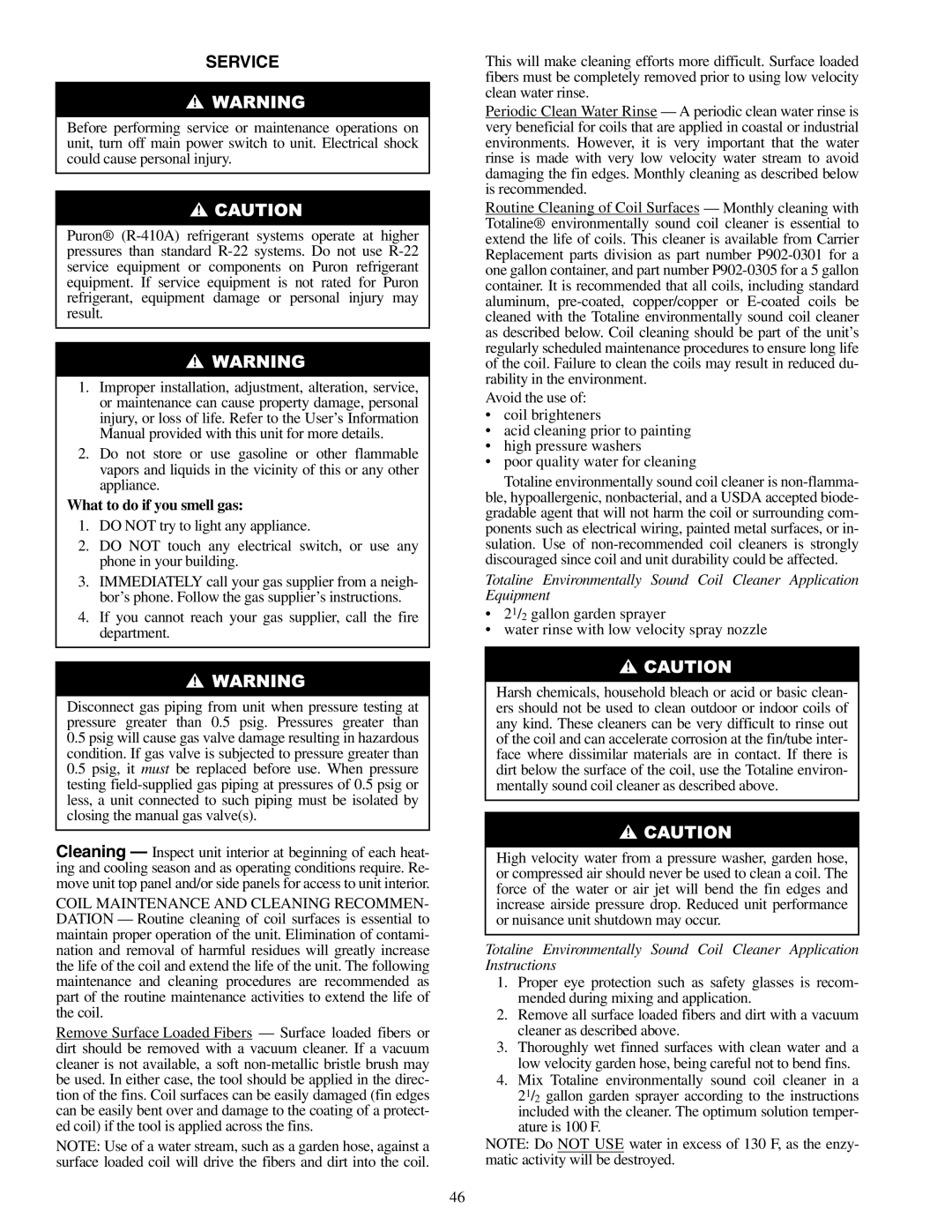
SERVICE
Before performing service or maintenance operations on unit, turn off main power switch to unit. Electrical shock could cause personal injury.
Puron®
1.Improper installation, adjustment, alteration, service, or maintenance can cause property damage, personal injury, or loss of life. Refer to the User’s Information Manual provided with this unit for more details.
2.Do not store or use gasoline or other flammable vapors and liquids in the vicinity of this or any other appliance.
What to do if you smell gas:
1.DO NOT try to light any appliance.
2.DO NOT touch any electrical switch, or use any phone in your building.
3.IMMEDIATELY call your gas supplier from a neigh- bor’s phone. Follow the gas supplier’s instructions.
4.If you cannot reach your gas supplier, call the fire department.
Disconnect gas piping from unit when pressure testing at pressure greater than 0.5 psig. Pressures greater than
0.5psig will cause gas valve damage resulting in hazardous condition. If gas valve is subjected to pressure greater than
0.5psig, it must be replaced before use. When pressure testing
Cleaning — Inspect unit interior at beginning of each heat- ing and cooling season and as operating conditions require. Re- move unit top panel and/or side panels for access to unit interior.
COIL MAINTENANCE AND CLEANING RECOMMEN- DATION — Routine cleaning of coil surfaces is essential to maintain proper operation of the unit. Elimination of contami- nation and removal of harmful residues will greatly increase the life of the coil and extend the life of the unit. The following maintenance and cleaning procedures are recommended as part of the routine maintenance activities to extend the life of the coil.
Remove Surface Loaded Fibers — Surface loaded fibers or dirt should be removed with a vacuum cleaner. If a vacuum cleaner is not available, a soft
NOTE: Use of a water stream, such as a garden hose, against a surface loaded coil will drive the fibers and dirt into the coil.
This will make cleaning efforts more difficult. Surface loaded fibers must be completely removed prior to using low velocity clean water rinse.
Periodic Clean Water Rinse — A periodic clean water rinse is very beneficial for coils that are applied in coastal or industrial environments. However, it is very important that the water rinse is made with very low velocity water stream to avoid damaging the fin edges. Monthly cleaning as described below is recommended.
Routine Cleaning of Coil Surfaces — Monthly cleaning with Totaline® environmentally sound coil cleaner is essential to extend the life of coils. This cleaner is available from Carrier Replacement parts division as part number
Avoid the use of:
•coil brighteners
•acid cleaning prior to painting
•high pressure washers
•poor quality water for cleaning
Totaline environmentally sound coil cleaner is
Totaline Environmentally Sound Coil Cleaner Application Equipment
•21/2 gallon garden sprayer
•water rinse with low velocity spray nozzle
Harsh chemicals, household bleach or acid or basic clean- ers should not be used to clean outdoor or indoor coils of any kind. These cleaners can be very difficult to rinse out of the coil and can accelerate corrosion at the fin/tube inter- face where dissimilar materials are in contact. If there is dirt below the surface of the coil, use the Totaline environ- mentally sound coil cleaner as described above.
High velocity water from a pressure washer, garden hose, or compressed air should never be used to clean a coil. The force of the water or air jet will bend the fin edges and increase airside pressure drop. Reduced unit performance or nuisance unit shutdown may occur.
Totaline Environmentally Sound Coil Cleaner Application Instructions
1.Proper eye protection such as safety glasses is recom- mended during mixing and application.
2.Remove all surface loaded fibers and dirt with a vacuum cleaner as described above.
3.Thoroughly wet finned surfaces with clean water and a low velocity garden hose, being careful not to bend fins.
4.Mix Totaline environmentally sound coil cleaner in a 21/2 gallon garden sprayer according to the instructions included with the cleaner. The optimum solution temper- ature is 100 F.
NOTE: Do NOT USE water in excess of 130 F, as the enzy- matic activity will be destroyed.
46
